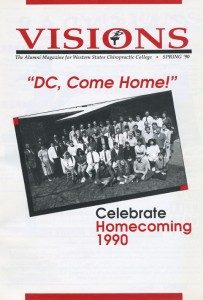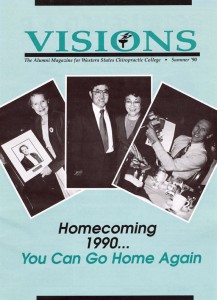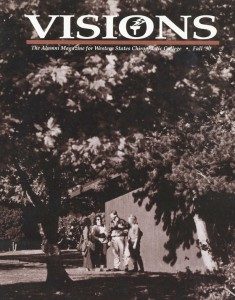Chapter 9, Part 5 – 1990 – 2000 Expansion and Ascension
1990 – 2000: Expansion and Ascension
- The Soviet Union collapsed and brought an end to the Cold War.
- Operation Desert Storm commenced with the invasion of Iraq.
- Nelson Mandela was elected president of South Africa.
- Oklahoma City Federal Building was bombed by American terrorists.
- Hong Kong was returned to China.
- Princess Diana died in car crash.
- Scientists cloned sheep.
- Tiger Woods won his first Master’s golf tournament.
- JFK, Jr. died in a plane crash.
- The ownership of the Panama Canal was returned to Panama.
If previous decades of feast and famine, expansion and contraction, progress and setbacks were indicators of an established trend, the college could have predicted the 1990s would present a similar pattern of challenges.
The administration and faculty worked diligently to find comfort with an organizational structure born of collective differences. The number of committees was reduced by half. Committee memberships were reduced in number; and the scope and function of each committee was re-defined. The re-configured president’s cabinet was meeting three times a week and communicating openly and broadly to the campus community. Much of 1990 was a period of transition. As administration and faculty continued to meet, it became apparent the college was grappling with some very deeply established core values and beliefs that, if left unresolved, would result in further impasse and immobility.
The entire campus found itself in the grip of a pervasive uneasiness. Tightly held beliefs and intractable positions assumed by various campus constituencies created an unhealthy climate of distrust, dissatisfaction and confusion.
Only in retrospect can reasons be given to explain the campus-wide discomfort:
- Students were confused and uneasy about their future as chiropractors. Students were challenged to choose from amongst a variety of practice options when advocacy for each was expressed by one or more of the faculty, administration, trustees or alums. There was simply no campus-wide agreement on what “brand” of chiropractic WSCC was providing. Most of the students had not yet received sufficient education and knowledge to make such monumental decisions.
- Although faculty members did not share the same degree of confusion expressed by students, neither did they agree on a model of chiropractic to promote on campus. Some came from backgrounds that emphasized empiricism and the scientific method; some came from chiropractic programs that emphasized chiropractic philosophy; still others came from clinical settings that were medically modeled. An unhealthy, unspoken agreement seemed to have evolved within the faculty whereby members chose to not challenge, confront, debate or ridicule another’s position. Lacking a unified approach to the chiropractic program, the academic divisions (basics sciences, clinical sciences, chiropractic sciences, clinics) were left to decide, somewhat autonomously, what each would teach and how to teach it. This approach gave life to virtually every point of view and negated none. It may have been a laudable demonstration of academic freedom, but for a single-purpose educational program, it simply invited confusion.
- The administration, board, and alumni were as diverse in their opinions about chiropractic as were faculty and students. They were equally disinclined to challenge, confront, debate or ridicule positions held by their counterparts.
The college was a rudderless boat, lacking a set of goals and objectives by which to unify it and crewed by disparate groups rowing in different directions. WSCC was having an identity crisis.
To move forward with any hope of success, the college would have to come to agreement on its “brand” of chiropractic. Finding agreement on a commonly accepted identity would require compromise. Compromise meant some positions and points of view would achieve greater importance, while others would fade. Not every voice would prevail, and some would grow silent. Recognizing how serious the situation was, the administration convened a series of meetings with various campus constituencies to address the identity issue head on. Participants would be required to “challenge, confront and debate,” but not ridicule. The college had to find consensus on the “brand” of chiropractic it would teach. The most active period of challenging, confronting, and debating took place in early 1990. It was a time-consuming, grueling, and often painful process that everyone agreed was necessary to achieve consensus. The candid discussions held on campus in 1990 produced greater clarity on the educational program the college wished to offer, but the conversation had only just begun. More time would be needed to refine the college’s position.

Visions, Spring 1990
By mid-1990, the college had completed and submitted its accreditation self-studies in preparation of a joint visitation from the CCE and the NWASC in the fall. This would be the first time representatives from both accrediting agencies conducted site visits simultaneously. The college felt prepared for the visit, knowing that both agencies would focus on strategic planning. In creating the strategic long range planning committee, the college had established both a vehicle and process by which to conduct future planning on an over-arching scale. The college was confident the plan submitted by the SLRP committee would satisfy both accreditation agencies.
As the college prepared for the joint accreditation visit, another chiropractic crisis began to slowly unfold, a crisis that would eventually involve WSCC. Initially, it was a crisis for the profession in Oregon, but before it was over, the crisis would spread to almost every state.
For more than a year, Oregon chiropractors had been hearing accusations by workers’ compensation insurance providers that some chiropractors were engaging in billing practices that were unprofessional, at the very least, and fraudulent at their worst. In April of 1990, what had been only rumblings, suddenly and dramatically escalated into a series of explosive events that played out on the evening news and in the pages of local and regional newspapers. Reporters of both mediums had been tipped-off that the Oregon attorney general was about to conduct a series of raids on a number of local chiropractors. The public watched the evening news as three chiropractors were led away from their offices in handcuffs. The three were arrested for allegedly filing fraudulent workers’ compensation claims. Six others were arrested in the same raid and charged with over-billing the State Accident Industrial Fund. Charges against the accused ranged from first-degree theft to mail fraud and racketeering.
Chiropractors indicted for fraud
The primary antagonist in this drama was a senior administrator for SAIF who claimed to have unearthed fraud by chiropractors and urged the attorney general to send “fraud squads” to arrest them, which he did. It took no time for this issue to find its way into the political arena; after all, it was an election year. The attorney general proposed to place chiropractic participation in the workers’ compensation system under the supervision and authority of the medical profession. Two gubernatorial candidates called for narrowing chiropractic participation in the workers’ compensation system and the sitting governor advocated for total exclusion of chiropractic participation.
The state chiropractic association publicly condemned illegal and unprofessional practices by any health care provider and issued a strongly-worded concern that SAIF had chosen to focus on the entire chiropractic profession, instead of the few chiropractors who allegedly engaged in misconduct. It took many months and more than a million dollars to litigate the criminal charges. Two of the chiropractors settled with SAIF for small fines, while three of the chiropractors chose to fight the charges against them, entering pleas of not guilty. The three were tried separately and each was found not guilty. In the end, no chiropractors were convicted, but the chiropractic profession suffered greatly as a result of this debacle. Chiropractors were allowed to continue their participation in the workers’ compensation system, but their role was greatly diminished and limitations were placed on the patient-care services they were allowed to provide. Many other states followed suit by employing similar measures to limit chiropractic participation in their respective workers’ compensation systems.
It is remarkably ironic that at the exact same time SAIF was claiming fraudulent practices by chiropractors, SAIF patient files were being reviewed by Dr. Nyiendo and her team of researchers. Dr. Nyiendo had received a $30,000 grant (signed by the governor) to conduct a retrospective study of SAIF files of patients presenting with low back pain. She was compiling and interpreting the data the very moment that SAIF and the “fraud quads” initiated action against targeted chiropractors.

Visions Summer 1990
In August 1990, SAIF produced a 665-page report detailing 1988 and 1989 provider payments. The report was especially critical of chiropractic care. Headlines in leading newspapers across Oregon read, “Chiropractors: Cases Prove to Be 2.5 Times More Expensive.” The October 1989 issue of Oregon Business reported, “The average cost per claim (for chiropractic care) was $703, compared to $284 for a medical doctor. Chiropractic claims are likely to remain open much longer, too.” Dr. Nyiendo knew that the information being fed to the press by SAIF was incorrect.
In a bold move, she appeared before a Legislative Hearing Committee to testify and provide supportive documentation that SAIF was misinterpreting the data and misleading the public. Her findings were confirmed by the Oregon Department of Insurance and Finance. In a letter to the speaker of the house, the Department of Insurance and Finances stated, “Dr. Nyiendo’s criticism of the use made of the 1988 data is essentially valid: the data did not fairly compare actual medical costs among providers.” Almost single-handedly, Dr. Nyiendo discredited the SAIF claims against the chiropractic profession. Unfortunately, severe damage had already been done to the chiropractic profession in Oregon. It would take years to recover. 1990 would end with Oregon chiropractors sporting a collective black-eye.
However, the college found itself more appreciated because of the willingness of Dr. Nyiendo to battle on behalf of the profession.
Nyiendo, WSCC researcher, discredits SAIF report
In fall 1990, Jim Gerber, DC, joined the clinical science division, where he became the lead instructor for courses relating to nutrition. Dr. Gerber authored numerous articles on the topic of nutrition and served as the college’s resident expert on this subject.

Visions, Fall 1990
The same fall, the college hired Ron LeFebvre, DC. Dr. LeFebvre focused his attention on clinical education and the preparation of students for clinical practice. Dr. LeFebvre was responsible for a number of projects that underscored the college’s dedication to excellence in chiropractic education. Dr. LeFebvre was responsible for organizing the faculty in the creation of the college’s conservative care pathways and clinical protocols. Some of the care pathways were published in chiropractic journals; all of them were made available to the entire profession through the college’s bookstore. Dr. LeFebvre also became the champion for clinical competency testing. Much of the success WSCC students have on the Part III and Part IV National Board Exams can be attributed to Dr. LeFebvre.
March 1990 Commencement Exercise Program
June 1990 Commencement Exercise Program
August 1990 Commencement Exercise Program
December 1990 Commencement Exercise Program
